Analysis of Competitive Advantages in Global Business Strategies
VerifiedAdded on 2022/12/27
|7
|2530
|1
Report
AI Summary
This report provides a comprehensive analysis of competitive advantages and business strategies employed by various companies. It begins by examining the global and socio-cultural elements impacting Starbucks, focusing on consumer preferences and lifestyle trends. The report then delves into Google's diversification strategies, categorizing them based on the level of product offerings. It further explores the rationale behind LVMH's acquisition of Tiffany, highlighting expansion into high-growth areas. Samsung's strategic alliance approaches are discussed, emphasizing building advantages, identifying loopholes, changing engagement terms, and collaboration. Zara's competitive behavior is analyzed, focusing on its fast adaptability to fashion trends, artificial scarcity tactics, and design variety. Finally, the report assesses the actions and characteristics of effective leadership, using QANTAS CEO Alan Joyce as a case study, emphasizing communication, trustworthiness, and vision.
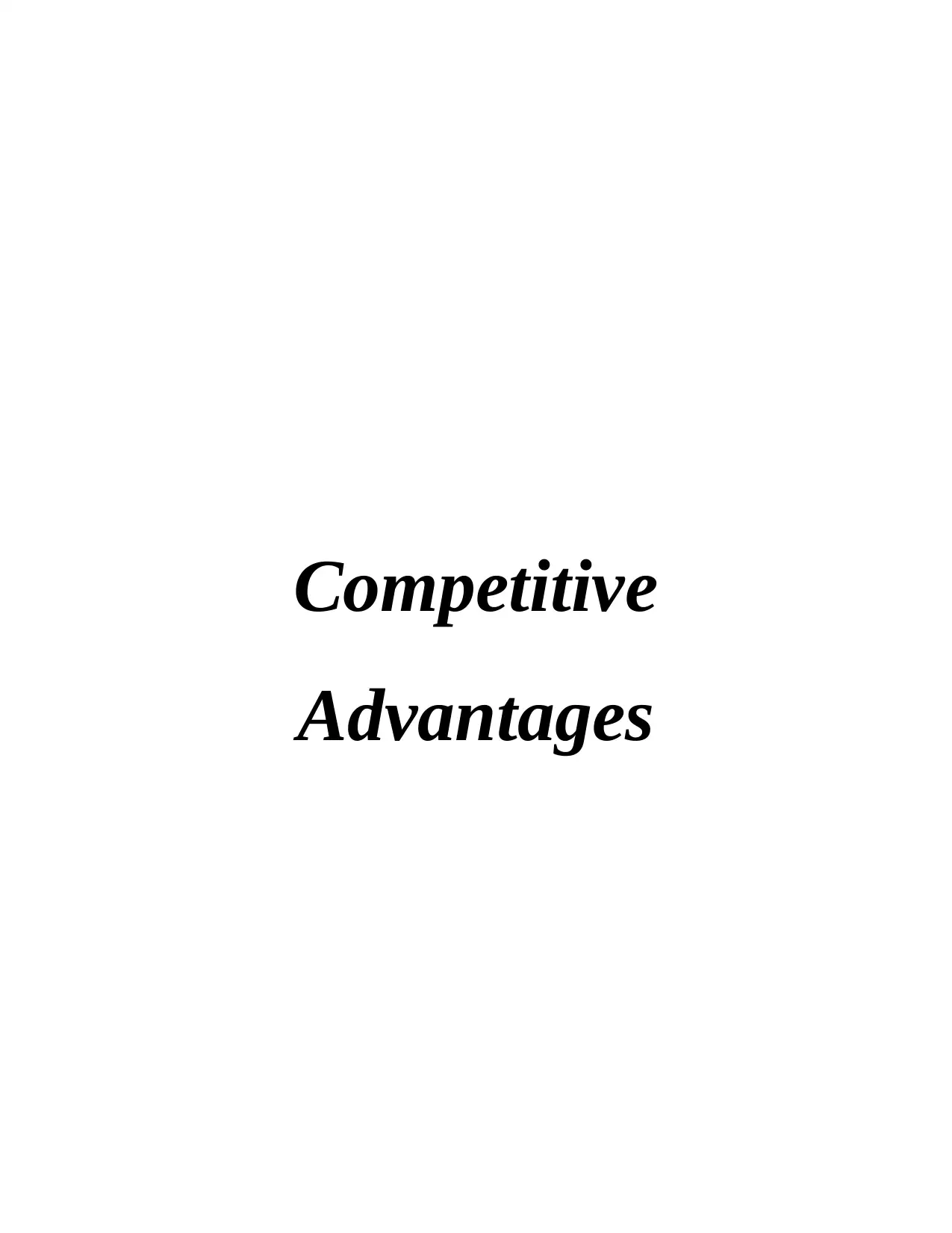
Competitive
Advantages
Advantages
Paraphrase This Document
Need a fresh take? Get an instant paraphrase of this document with our AI Paraphraser
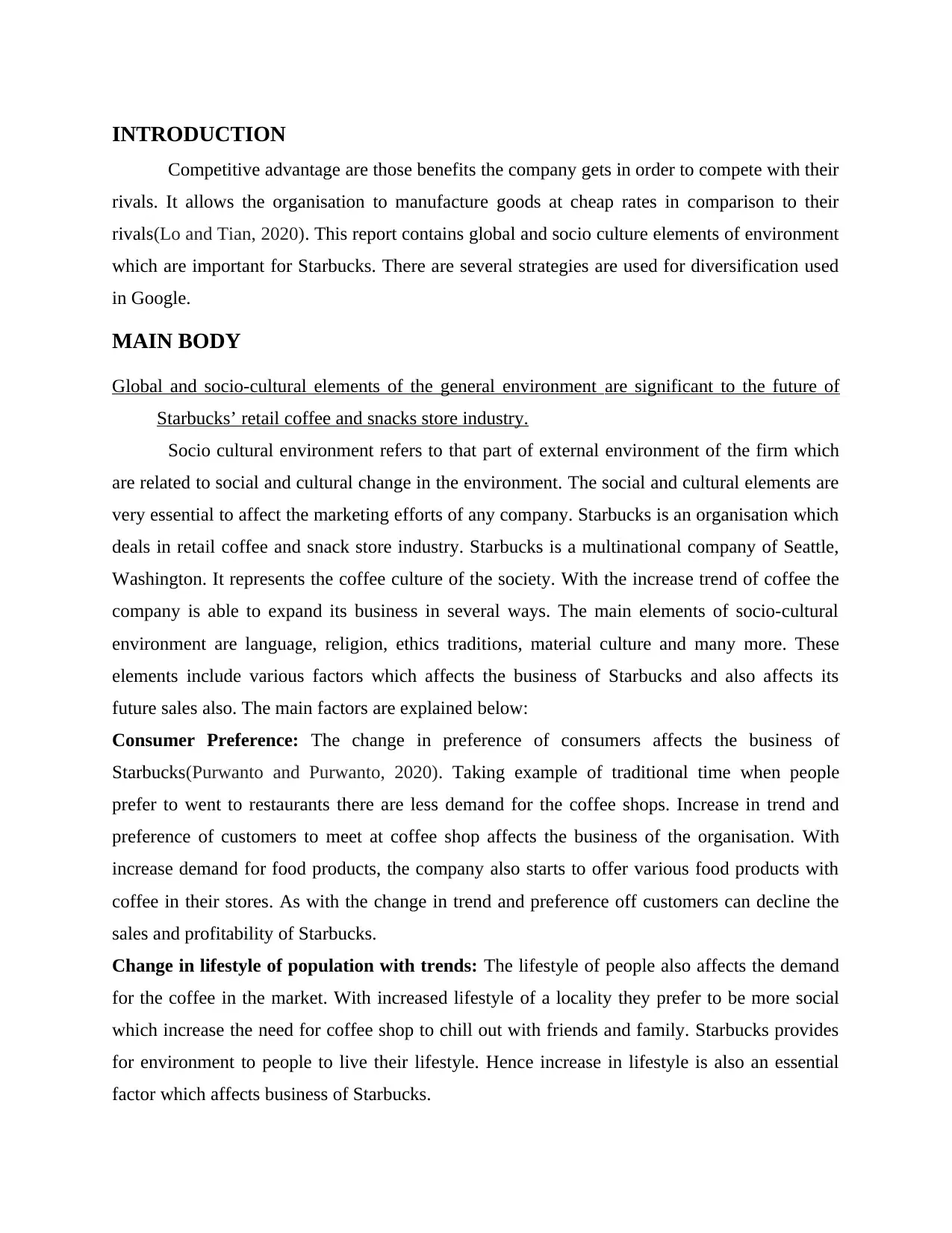
INTRODUCTION
Competitive advantage are those benefits the company gets in order to compete with their
rivals. It allows the organisation to manufacture goods at cheap rates in comparison to their
rivals(Lo and Tian, 2020). This report contains global and socio culture elements of environment
which are important for Starbucks. There are several strategies are used for diversification used
in Google.
MAIN BODY
Global and socio-cultural elements of the general environment are significant to the future of
Starbucks’ retail coffee and snacks store industry.
Socio cultural environment refers to that part of external environment of the firm which
are related to social and cultural change in the environment. The social and cultural elements are
very essential to affect the marketing efforts of any company. Starbucks is an organisation which
deals in retail coffee and snack store industry. Starbucks is a multinational company of Seattle,
Washington. It represents the coffee culture of the society. With the increase trend of coffee the
company is able to expand its business in several ways. The main elements of socio-cultural
environment are language, religion, ethics traditions, material culture and many more. These
elements include various factors which affects the business of Starbucks and also affects its
future sales also. The main factors are explained below:
Consumer Preference: The change in preference of consumers affects the business of
Starbucks(Purwanto and Purwanto, 2020). Taking example of traditional time when people
prefer to went to restaurants there are less demand for the coffee shops. Increase in trend and
preference of customers to meet at coffee shop affects the business of the organisation. With
increase demand for food products, the company also starts to offer various food products with
coffee in their stores. As with the change in trend and preference off customers can decline the
sales and profitability of Starbucks.
Change in lifestyle of population with trends: The lifestyle of people also affects the demand
for the coffee in the market. With increased lifestyle of a locality they prefer to be more social
which increase the need for coffee shop to chill out with friends and family. Starbucks provides
for environment to people to live their lifestyle. Hence increase in lifestyle is also an essential
factor which affects business of Starbucks.
Competitive advantage are those benefits the company gets in order to compete with their
rivals. It allows the organisation to manufacture goods at cheap rates in comparison to their
rivals(Lo and Tian, 2020). This report contains global and socio culture elements of environment
which are important for Starbucks. There are several strategies are used for diversification used
in Google.
MAIN BODY
Global and socio-cultural elements of the general environment are significant to the future of
Starbucks’ retail coffee and snacks store industry.
Socio cultural environment refers to that part of external environment of the firm which
are related to social and cultural change in the environment. The social and cultural elements are
very essential to affect the marketing efforts of any company. Starbucks is an organisation which
deals in retail coffee and snack store industry. Starbucks is a multinational company of Seattle,
Washington. It represents the coffee culture of the society. With the increase trend of coffee the
company is able to expand its business in several ways. The main elements of socio-cultural
environment are language, religion, ethics traditions, material culture and many more. These
elements include various factors which affects the business of Starbucks and also affects its
future sales also. The main factors are explained below:
Consumer Preference: The change in preference of consumers affects the business of
Starbucks(Purwanto and Purwanto, 2020). Taking example of traditional time when people
prefer to went to restaurants there are less demand for the coffee shops. Increase in trend and
preference of customers to meet at coffee shop affects the business of the organisation. With
increase demand for food products, the company also starts to offer various food products with
coffee in their stores. As with the change in trend and preference off customers can decline the
sales and profitability of Starbucks.
Change in lifestyle of population with trends: The lifestyle of people also affects the demand
for the coffee in the market. With increased lifestyle of a locality they prefer to be more social
which increase the need for coffee shop to chill out with friends and family. Starbucks provides
for environment to people to live their lifestyle. Hence increase in lifestyle is also an essential
factor which affects business of Starbucks.
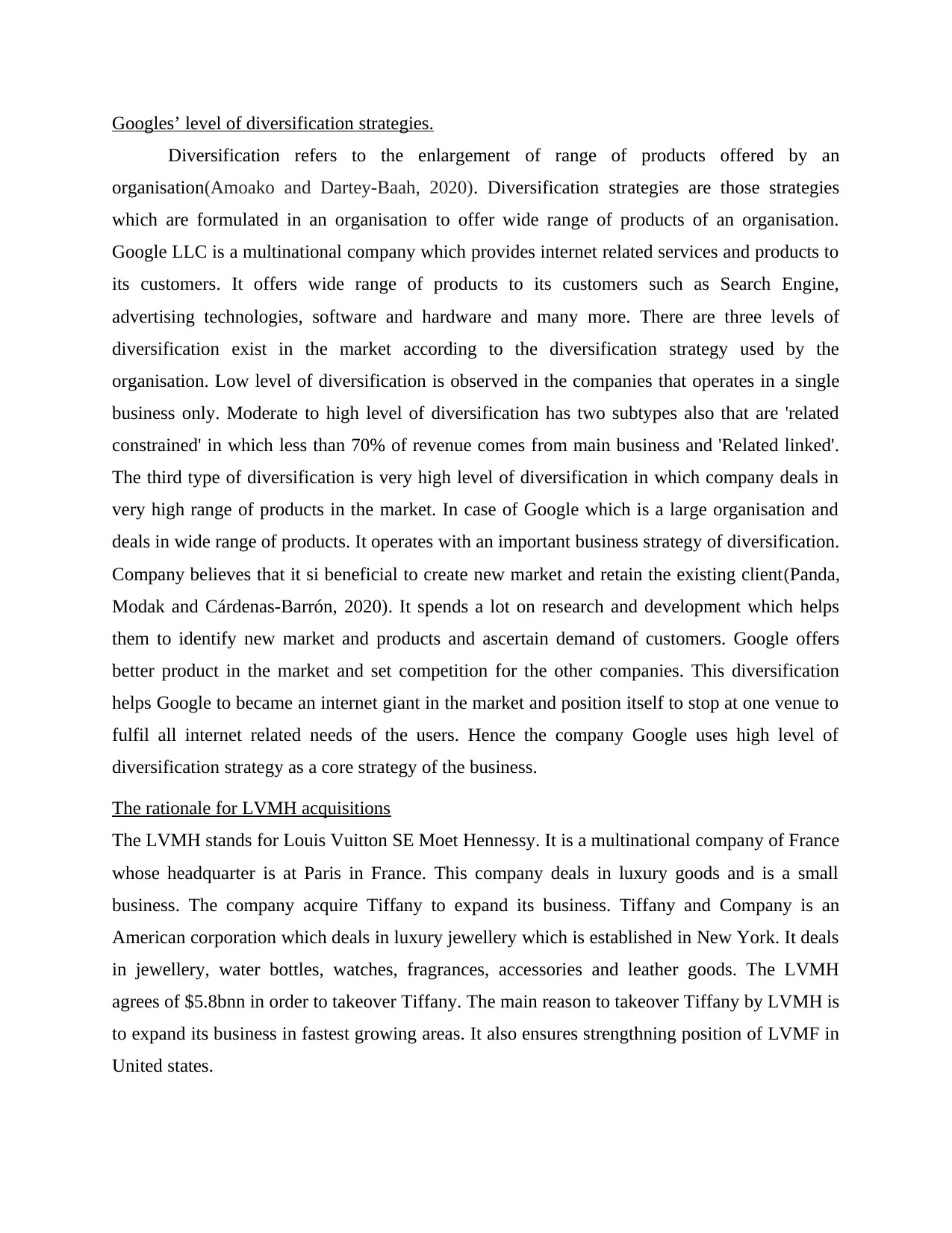
Googles’ level of diversification strategies.
Diversification refers to the enlargement of range of products offered by an
organisation(Amoako and Dartey-Baah, 2020). Diversification strategies are those strategies
which are formulated in an organisation to offer wide range of products of an organisation.
Google LLC is a multinational company which provides internet related services and products to
its customers. It offers wide range of products to its customers such as Search Engine,
advertising technologies, software and hardware and many more. There are three levels of
diversification exist in the market according to the diversification strategy used by the
organisation. Low level of diversification is observed in the companies that operates in a single
business only. Moderate to high level of diversification has two subtypes also that are 'related
constrained' in which less than 70% of revenue comes from main business and 'Related linked'.
The third type of diversification is very high level of diversification in which company deals in
very high range of products in the market. In case of Google which is a large organisation and
deals in wide range of products. It operates with an important business strategy of diversification.
Company believes that it si beneficial to create new market and retain the existing client(Panda,
Modak and Cárdenas-Barrón, 2020). It spends a lot on research and development which helps
them to identify new market and products and ascertain demand of customers. Google offers
better product in the market and set competition for the other companies. This diversification
helps Google to became an internet giant in the market and position itself to stop at one venue to
fulfil all internet related needs of the users. Hence the company Google uses high level of
diversification strategy as a core strategy of the business.
The rationale for LVMH acquisitions
The LVMH stands for Louis Vuitton SE Moet Hennessy. It is a multinational company of France
whose headquarter is at Paris in France. This company deals in luxury goods and is a small
business. The company acquire Tiffany to expand its business. Tiffany and Company is an
American corporation which deals in luxury jewellery which is established in New York. It deals
in jewellery, water bottles, watches, fragrances, accessories and leather goods. The LVMH
agrees of $5.8bnn in order to takeover Tiffany. The main reason to takeover Tiffany by LVMH is
to expand its business in fastest growing areas. It also ensures strengthning position of LVMF in
United states.
Diversification refers to the enlargement of range of products offered by an
organisation(Amoako and Dartey-Baah, 2020). Diversification strategies are those strategies
which are formulated in an organisation to offer wide range of products of an organisation.
Google LLC is a multinational company which provides internet related services and products to
its customers. It offers wide range of products to its customers such as Search Engine,
advertising technologies, software and hardware and many more. There are three levels of
diversification exist in the market according to the diversification strategy used by the
organisation. Low level of diversification is observed in the companies that operates in a single
business only. Moderate to high level of diversification has two subtypes also that are 'related
constrained' in which less than 70% of revenue comes from main business and 'Related linked'.
The third type of diversification is very high level of diversification in which company deals in
very high range of products in the market. In case of Google which is a large organisation and
deals in wide range of products. It operates with an important business strategy of diversification.
Company believes that it si beneficial to create new market and retain the existing client(Panda,
Modak and Cárdenas-Barrón, 2020). It spends a lot on research and development which helps
them to identify new market and products and ascertain demand of customers. Google offers
better product in the market and set competition for the other companies. This diversification
helps Google to became an internet giant in the market and position itself to stop at one venue to
fulfil all internet related needs of the users. Hence the company Google uses high level of
diversification strategy as a core strategy of the business.
The rationale for LVMH acquisitions
The LVMH stands for Louis Vuitton SE Moet Hennessy. It is a multinational company of France
whose headquarter is at Paris in France. This company deals in luxury goods and is a small
business. The company acquire Tiffany to expand its business. Tiffany and Company is an
American corporation which deals in luxury jewellery which is established in New York. It deals
in jewellery, water bottles, watches, fragrances, accessories and leather goods. The LVMH
agrees of $5.8bnn in order to takeover Tiffany. The main reason to takeover Tiffany by LVMH is
to expand its business in fastest growing areas. It also ensures strengthning position of LVMF in
United states.
⊘ This is a preview!⊘
Do you want full access?
Subscribe today to unlock all pages.

Trusted by 1+ million students worldwide
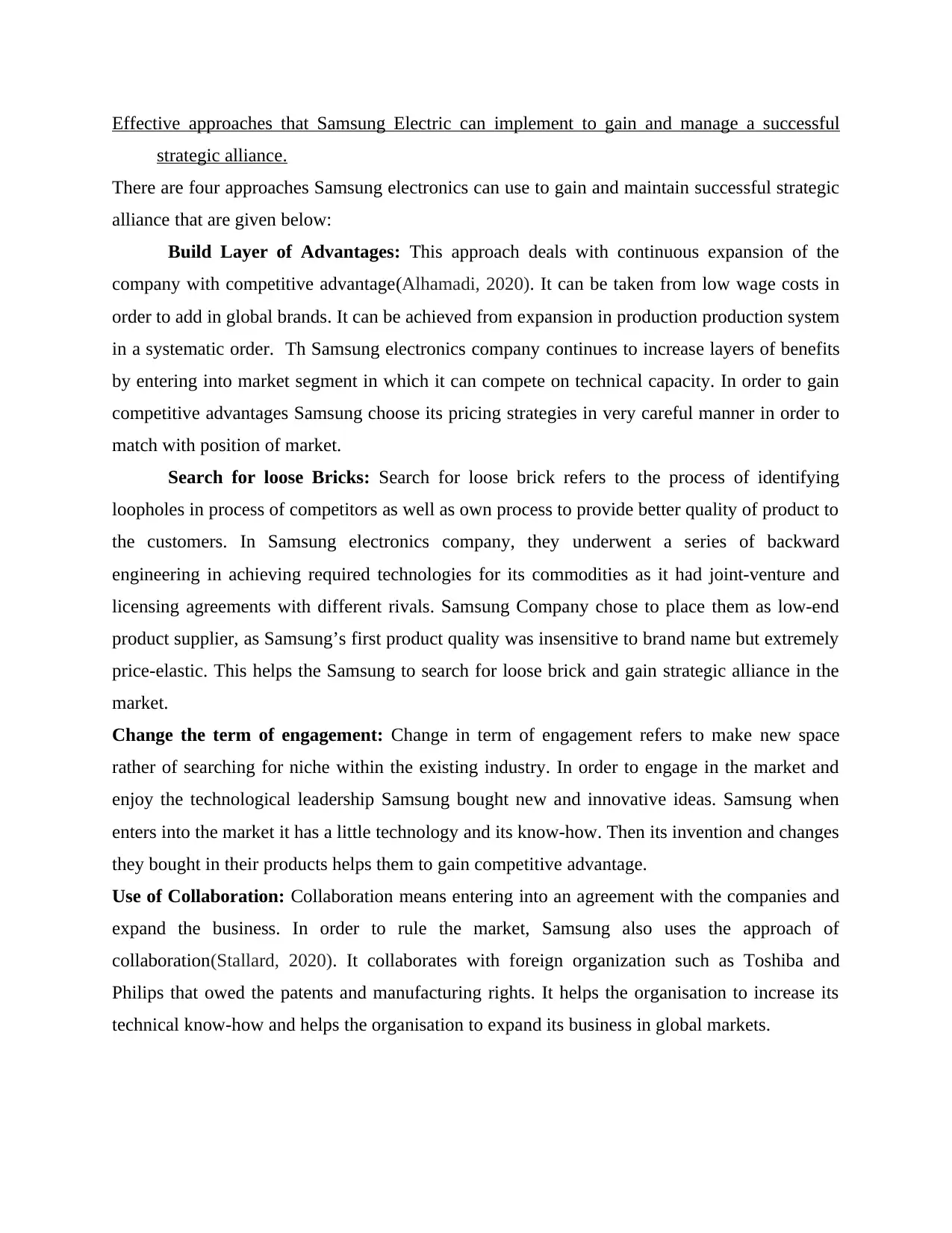
Effective approaches that Samsung Electric can implement to gain and manage a successful
strategic alliance.
There are four approaches Samsung electronics can use to gain and maintain successful strategic
alliance that are given below:
Build Layer of Advantages: This approach deals with continuous expansion of the
company with competitive advantage(Alhamadi, 2020). It can be taken from low wage costs in
order to add in global brands. It can be achieved from expansion in production production system
in a systematic order. Th Samsung electronics company continues to increase layers of benefits
by entering into market segment in which it can compete on technical capacity. In order to gain
competitive advantages Samsung choose its pricing strategies in very careful manner in order to
match with position of market.
Search for loose Bricks: Search for loose brick refers to the process of identifying
loopholes in process of competitors as well as own process to provide better quality of product to
the customers. In Samsung electronics company, they underwent a series of backward
engineering in achieving required technologies for its commodities as it had joint-venture and
licensing agreements with different rivals. Samsung Company chose to place them as low-end
product supplier, as Samsung’s first product quality was insensitive to brand name but extremely
price-elastic. This helps the Samsung to search for loose brick and gain strategic alliance in the
market.
Change the term of engagement: Change in term of engagement refers to make new space
rather of searching for niche within the existing industry. In order to engage in the market and
enjoy the technological leadership Samsung bought new and innovative ideas. Samsung when
enters into the market it has a little technology and its know-how. Then its invention and changes
they bought in their products helps them to gain competitive advantage.
Use of Collaboration: Collaboration means entering into an agreement with the companies and
expand the business. In order to rule the market, Samsung also uses the approach of
collaboration(Stallard, 2020). It collaborates with foreign organization such as Toshiba and
Philips that owed the patents and manufacturing rights. It helps the organisation to increase its
technical know-how and helps the organisation to expand its business in global markets.
strategic alliance.
There are four approaches Samsung electronics can use to gain and maintain successful strategic
alliance that are given below:
Build Layer of Advantages: This approach deals with continuous expansion of the
company with competitive advantage(Alhamadi, 2020). It can be taken from low wage costs in
order to add in global brands. It can be achieved from expansion in production production system
in a systematic order. Th Samsung electronics company continues to increase layers of benefits
by entering into market segment in which it can compete on technical capacity. In order to gain
competitive advantages Samsung choose its pricing strategies in very careful manner in order to
match with position of market.
Search for loose Bricks: Search for loose brick refers to the process of identifying
loopholes in process of competitors as well as own process to provide better quality of product to
the customers. In Samsung electronics company, they underwent a series of backward
engineering in achieving required technologies for its commodities as it had joint-venture and
licensing agreements with different rivals. Samsung Company chose to place them as low-end
product supplier, as Samsung’s first product quality was insensitive to brand name but extremely
price-elastic. This helps the Samsung to search for loose brick and gain strategic alliance in the
market.
Change the term of engagement: Change in term of engagement refers to make new space
rather of searching for niche within the existing industry. In order to engage in the market and
enjoy the technological leadership Samsung bought new and innovative ideas. Samsung when
enters into the market it has a little technology and its know-how. Then its invention and changes
they bought in their products helps them to gain competitive advantage.
Use of Collaboration: Collaboration means entering into an agreement with the companies and
expand the business. In order to rule the market, Samsung also uses the approach of
collaboration(Stallard, 2020). It collaborates with foreign organization such as Toshiba and
Philips that owed the patents and manufacturing rights. It helps the organisation to increase its
technical know-how and helps the organisation to expand its business in global markets.
Paraphrase This Document
Need a fresh take? Get an instant paraphrase of this document with our AI Paraphraser
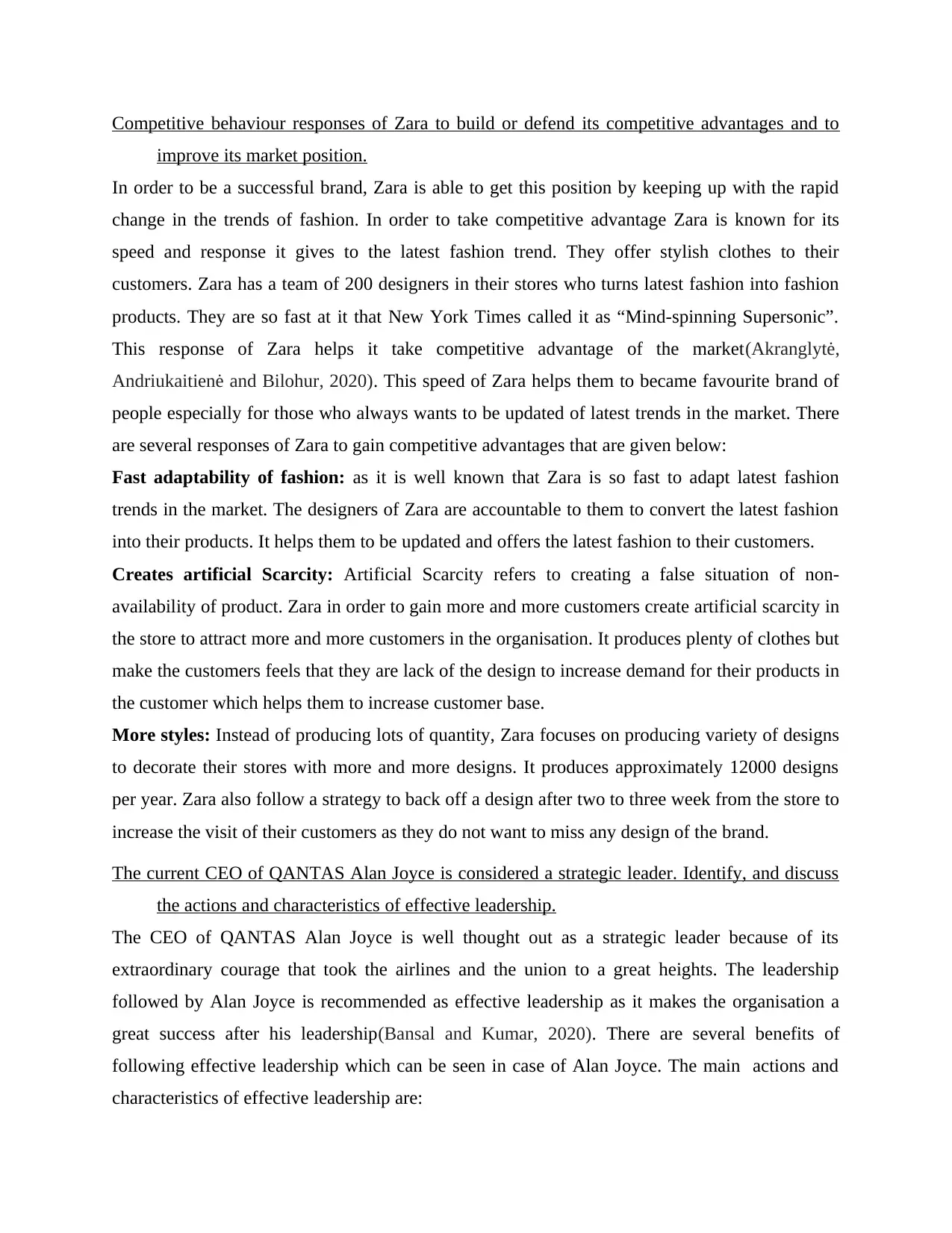
Competitive behaviour responses of Zara to build or defend its competitive advantages and to
improve its market position.
In order to be a successful brand, Zara is able to get this position by keeping up with the rapid
change in the trends of fashion. In order to take competitive advantage Zara is known for its
speed and response it gives to the latest fashion trend. They offer stylish clothes to their
customers. Zara has a team of 200 designers in their stores who turns latest fashion into fashion
products. They are so fast at it that New York Times called it as “Mind-spinning Supersonic”.
This response of Zara helps it take competitive advantage of the market(Akranglytė,
Andriukaitienė and Bilohur, 2020). This speed of Zara helps them to became favourite brand of
people especially for those who always wants to be updated of latest trends in the market. There
are several responses of Zara to gain competitive advantages that are given below:
Fast adaptability of fashion: as it is well known that Zara is so fast to adapt latest fashion
trends in the market. The designers of Zara are accountable to them to convert the latest fashion
into their products. It helps them to be updated and offers the latest fashion to their customers.
Creates artificial Scarcity: Artificial Scarcity refers to creating a false situation of non-
availability of product. Zara in order to gain more and more customers create artificial scarcity in
the store to attract more and more customers in the organisation. It produces plenty of clothes but
make the customers feels that they are lack of the design to increase demand for their products in
the customer which helps them to increase customer base.
More styles: Instead of producing lots of quantity, Zara focuses on producing variety of designs
to decorate their stores with more and more designs. It produces approximately 12000 designs
per year. Zara also follow a strategy to back off a design after two to three week from the store to
increase the visit of their customers as they do not want to miss any design of the brand.
The current CEO of QANTAS Alan Joyce is considered a strategic leader. Identify, and discuss
the actions and characteristics of effective leadership.
The CEO of QANTAS Alan Joyce is well thought out as a strategic leader because of its
extraordinary courage that took the airlines and the union to a great heights. The leadership
followed by Alan Joyce is recommended as effective leadership as it makes the organisation a
great success after his leadership(Bansal and Kumar, 2020). There are several benefits of
following effective leadership which can be seen in case of Alan Joyce. The main actions and
characteristics of effective leadership are:
improve its market position.
In order to be a successful brand, Zara is able to get this position by keeping up with the rapid
change in the trends of fashion. In order to take competitive advantage Zara is known for its
speed and response it gives to the latest fashion trend. They offer stylish clothes to their
customers. Zara has a team of 200 designers in their stores who turns latest fashion into fashion
products. They are so fast at it that New York Times called it as “Mind-spinning Supersonic”.
This response of Zara helps it take competitive advantage of the market(Akranglytė,
Andriukaitienė and Bilohur, 2020). This speed of Zara helps them to became favourite brand of
people especially for those who always wants to be updated of latest trends in the market. There
are several responses of Zara to gain competitive advantages that are given below:
Fast adaptability of fashion: as it is well known that Zara is so fast to adapt latest fashion
trends in the market. The designers of Zara are accountable to them to convert the latest fashion
into their products. It helps them to be updated and offers the latest fashion to their customers.
Creates artificial Scarcity: Artificial Scarcity refers to creating a false situation of non-
availability of product. Zara in order to gain more and more customers create artificial scarcity in
the store to attract more and more customers in the organisation. It produces plenty of clothes but
make the customers feels that they are lack of the design to increase demand for their products in
the customer which helps them to increase customer base.
More styles: Instead of producing lots of quantity, Zara focuses on producing variety of designs
to decorate their stores with more and more designs. It produces approximately 12000 designs
per year. Zara also follow a strategy to back off a design after two to three week from the store to
increase the visit of their customers as they do not want to miss any design of the brand.
The current CEO of QANTAS Alan Joyce is considered a strategic leader. Identify, and discuss
the actions and characteristics of effective leadership.
The CEO of QANTAS Alan Joyce is well thought out as a strategic leader because of its
extraordinary courage that took the airlines and the union to a great heights. The leadership
followed by Alan Joyce is recommended as effective leadership as it makes the organisation a
great success after his leadership(Bansal and Kumar, 2020). There are several benefits of
following effective leadership which can be seen in case of Alan Joyce. The main actions and
characteristics of effective leadership are:
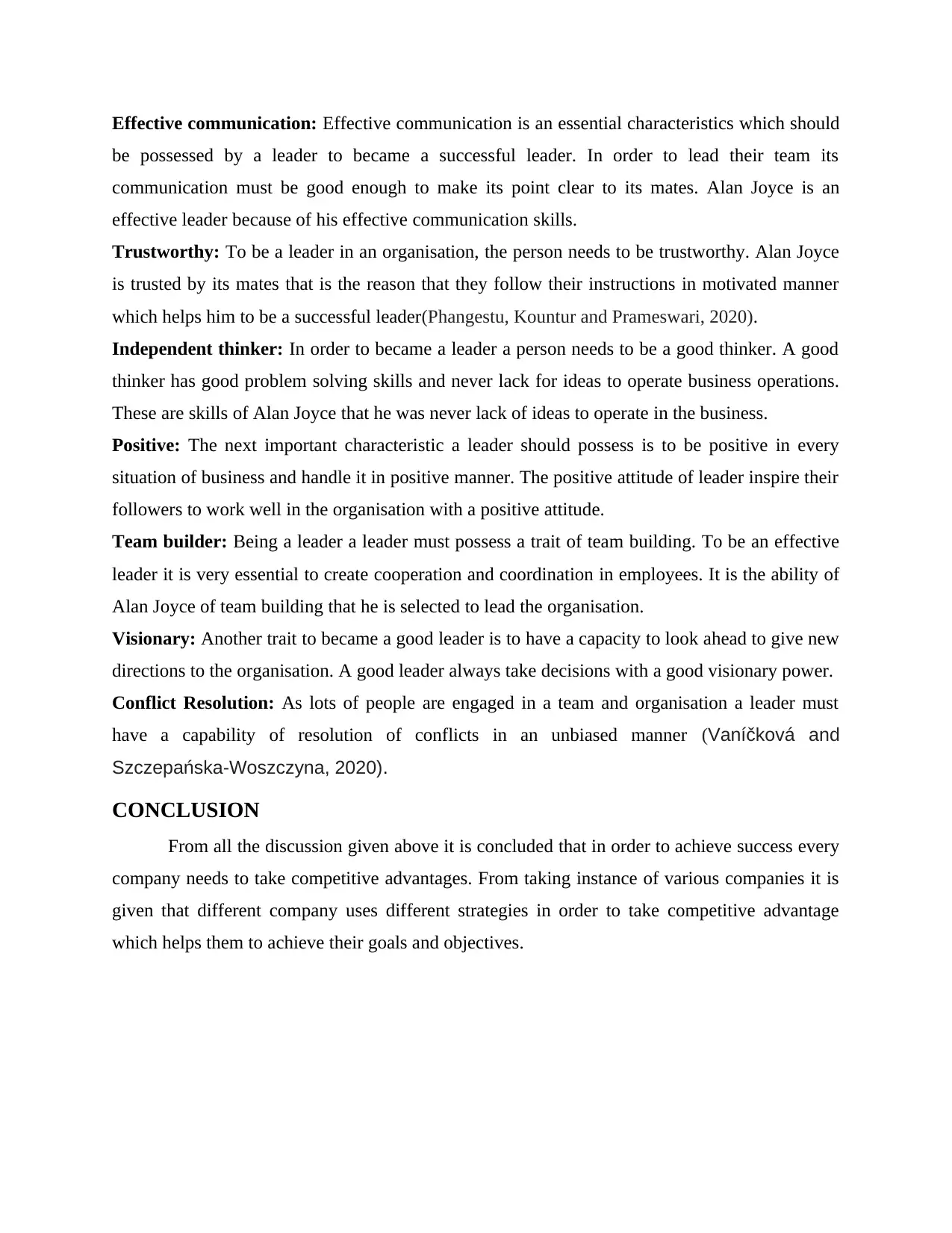
Effective communication: Effective communication is an essential characteristics which should
be possessed by a leader to became a successful leader. In order to lead their team its
communication must be good enough to make its point clear to its mates. Alan Joyce is an
effective leader because of his effective communication skills.
Trustworthy: To be a leader in an organisation, the person needs to be trustworthy. Alan Joyce
is trusted by its mates that is the reason that they follow their instructions in motivated manner
which helps him to be a successful leader(Phangestu, Kountur and Prameswari, 2020).
Independent thinker: In order to became a leader a person needs to be a good thinker. A good
thinker has good problem solving skills and never lack for ideas to operate business operations.
These are skills of Alan Joyce that he was never lack of ideas to operate in the business.
Positive: The next important characteristic a leader should possess is to be positive in every
situation of business and handle it in positive manner. The positive attitude of leader inspire their
followers to work well in the organisation with a positive attitude.
Team builder: Being a leader a leader must possess a trait of team building. To be an effective
leader it is very essential to create cooperation and coordination in employees. It is the ability of
Alan Joyce of team building that he is selected to lead the organisation.
Visionary: Another trait to became a good leader is to have a capacity to look ahead to give new
directions to the organisation. A good leader always take decisions with a good visionary power.
Conflict Resolution: As lots of people are engaged in a team and organisation a leader must
have a capability of resolution of conflicts in an unbiased manner (Vaníčková and
Szczepańska-Woszczyna, 2020).
CONCLUSION
From all the discussion given above it is concluded that in order to achieve success every
company needs to take competitive advantages. From taking instance of various companies it is
given that different company uses different strategies in order to take competitive advantage
which helps them to achieve their goals and objectives.
be possessed by a leader to became a successful leader. In order to lead their team its
communication must be good enough to make its point clear to its mates. Alan Joyce is an
effective leader because of his effective communication skills.
Trustworthy: To be a leader in an organisation, the person needs to be trustworthy. Alan Joyce
is trusted by its mates that is the reason that they follow their instructions in motivated manner
which helps him to be a successful leader(Phangestu, Kountur and Prameswari, 2020).
Independent thinker: In order to became a leader a person needs to be a good thinker. A good
thinker has good problem solving skills and never lack for ideas to operate business operations.
These are skills of Alan Joyce that he was never lack of ideas to operate in the business.
Positive: The next important characteristic a leader should possess is to be positive in every
situation of business and handle it in positive manner. The positive attitude of leader inspire their
followers to work well in the organisation with a positive attitude.
Team builder: Being a leader a leader must possess a trait of team building. To be an effective
leader it is very essential to create cooperation and coordination in employees. It is the ability of
Alan Joyce of team building that he is selected to lead the organisation.
Visionary: Another trait to became a good leader is to have a capacity to look ahead to give new
directions to the organisation. A good leader always take decisions with a good visionary power.
Conflict Resolution: As lots of people are engaged in a team and organisation a leader must
have a capability of resolution of conflicts in an unbiased manner (Vaníčková and
Szczepańska-Woszczyna, 2020).
CONCLUSION
From all the discussion given above it is concluded that in order to achieve success every
company needs to take competitive advantages. From taking instance of various companies it is
given that different company uses different strategies in order to take competitive advantage
which helps them to achieve their goals and objectives.
⊘ This is a preview!⊘
Do you want full access?
Subscribe today to unlock all pages.

Trusted by 1+ million students worldwide
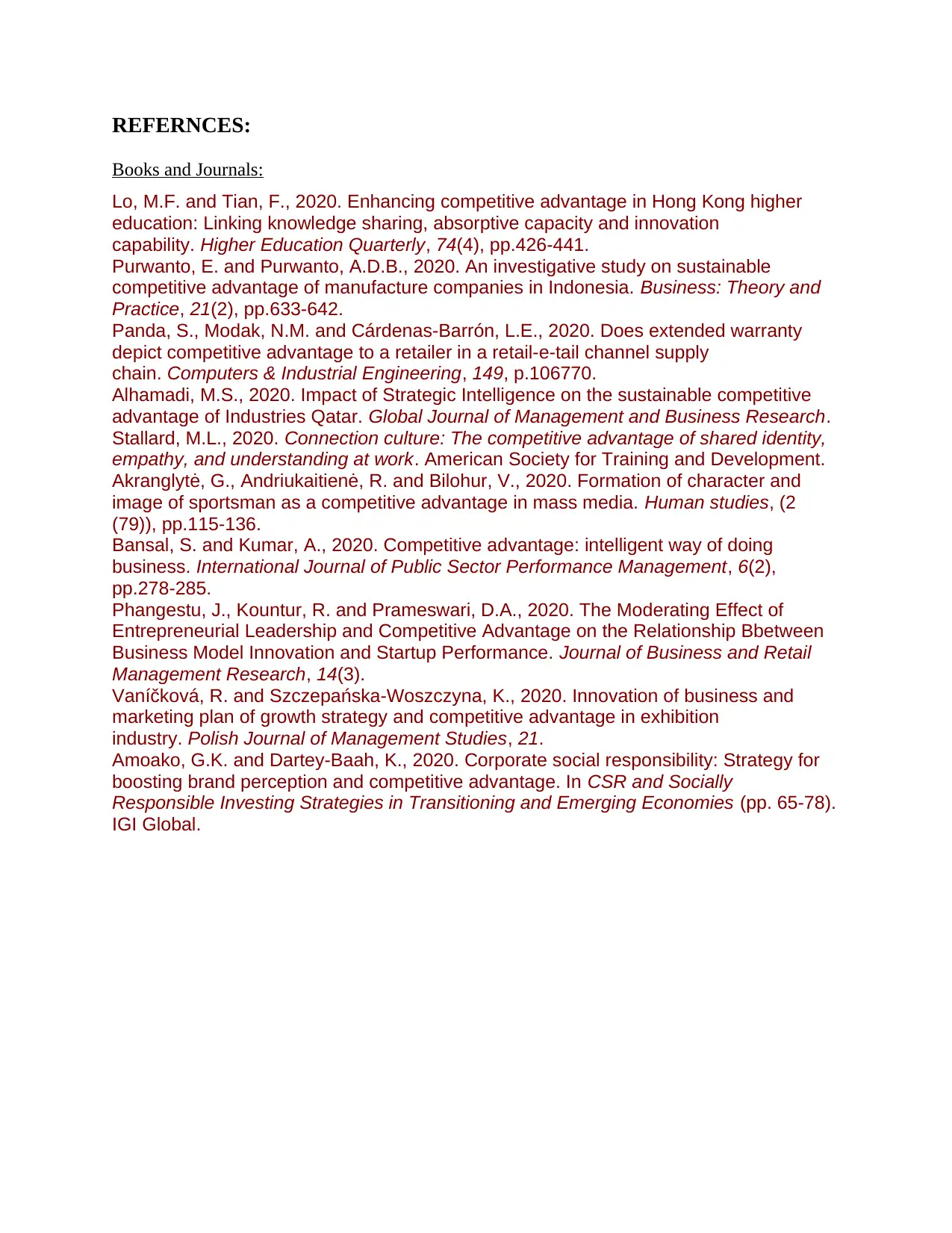
REFERNCES:
Books and Journals:
Lo, M.F. and Tian, F., 2020. Enhancing competitive advantage in Hong Kong higher
education: Linking knowledge sharing, absorptive capacity and innovation
capability. Higher Education Quarterly, 74(4), pp.426-441.
Purwanto, E. and Purwanto, A.D.B., 2020. An investigative study on sustainable
competitive advantage of manufacture companies in Indonesia. Business: Theory and
Practice, 21(2), pp.633-642.
Panda, S., Modak, N.M. and Cárdenas-Barrón, L.E., 2020. Does extended warranty
depict competitive advantage to a retailer in a retail-e-tail channel supply
chain. Computers & Industrial Engineering, 149, p.106770.
Alhamadi, M.S., 2020. Impact of Strategic Intelligence on the sustainable competitive
advantage of Industries Qatar. Global Journal of Management and Business Research.
Stallard, M.L., 2020. Connection culture: The competitive advantage of shared identity,
empathy, and understanding at work. American Society for Training and Development.
Akranglytė, G., Andriukaitienė, R. and Bilohur, V., 2020. Formation of character and
image of sportsman as a competitive advantage in mass media. Human studies, (2
(79)), pp.115-136.
Bansal, S. and Kumar, A., 2020. Competitive advantage: intelligent way of doing
business. International Journal of Public Sector Performance Management, 6(2),
pp.278-285.
Phangestu, J., Kountur, R. and Prameswari, D.A., 2020. The Moderating Effect of
Entrepreneurial Leadership and Competitive Advantage on the Relationship Bbetween
Business Model Innovation and Startup Performance. Journal of Business and Retail
Management Research, 14(3).
Vaníčková, R. and Szczepańska-Woszczyna, K., 2020. Innovation of business and
marketing plan of growth strategy and competitive advantage in exhibition
industry. Polish Journal of Management Studies, 21.
Amoako, G.K. and Dartey-Baah, K., 2020. Corporate social responsibility: Strategy for
boosting brand perception and competitive advantage. In CSR and Socially
Responsible Investing Strategies in Transitioning and Emerging Economies (pp. 65-78).
IGI Global.
Books and Journals:
Lo, M.F. and Tian, F., 2020. Enhancing competitive advantage in Hong Kong higher
education: Linking knowledge sharing, absorptive capacity and innovation
capability. Higher Education Quarterly, 74(4), pp.426-441.
Purwanto, E. and Purwanto, A.D.B., 2020. An investigative study on sustainable
competitive advantage of manufacture companies in Indonesia. Business: Theory and
Practice, 21(2), pp.633-642.
Panda, S., Modak, N.M. and Cárdenas-Barrón, L.E., 2020. Does extended warranty
depict competitive advantage to a retailer in a retail-e-tail channel supply
chain. Computers & Industrial Engineering, 149, p.106770.
Alhamadi, M.S., 2020. Impact of Strategic Intelligence on the sustainable competitive
advantage of Industries Qatar. Global Journal of Management and Business Research.
Stallard, M.L., 2020. Connection culture: The competitive advantage of shared identity,
empathy, and understanding at work. American Society for Training and Development.
Akranglytė, G., Andriukaitienė, R. and Bilohur, V., 2020. Formation of character and
image of sportsman as a competitive advantage in mass media. Human studies, (2
(79)), pp.115-136.
Bansal, S. and Kumar, A., 2020. Competitive advantage: intelligent way of doing
business. International Journal of Public Sector Performance Management, 6(2),
pp.278-285.
Phangestu, J., Kountur, R. and Prameswari, D.A., 2020. The Moderating Effect of
Entrepreneurial Leadership and Competitive Advantage on the Relationship Bbetween
Business Model Innovation and Startup Performance. Journal of Business and Retail
Management Research, 14(3).
Vaníčková, R. and Szczepańska-Woszczyna, K., 2020. Innovation of business and
marketing plan of growth strategy and competitive advantage in exhibition
industry. Polish Journal of Management Studies, 21.
Amoako, G.K. and Dartey-Baah, K., 2020. Corporate social responsibility: Strategy for
boosting brand perception and competitive advantage. In CSR and Socially
Responsible Investing Strategies in Transitioning and Emerging Economies (pp. 65-78).
IGI Global.
1 out of 7
Related Documents
Your All-in-One AI-Powered Toolkit for Academic Success.
+13062052269
info@desklib.com
Available 24*7 on WhatsApp / Email
![[object Object]](/_next/static/media/star-bottom.7253800d.svg)
Unlock your academic potential
Copyright © 2020–2025 A2Z Services. All Rights Reserved. Developed and managed by ZUCOL.




